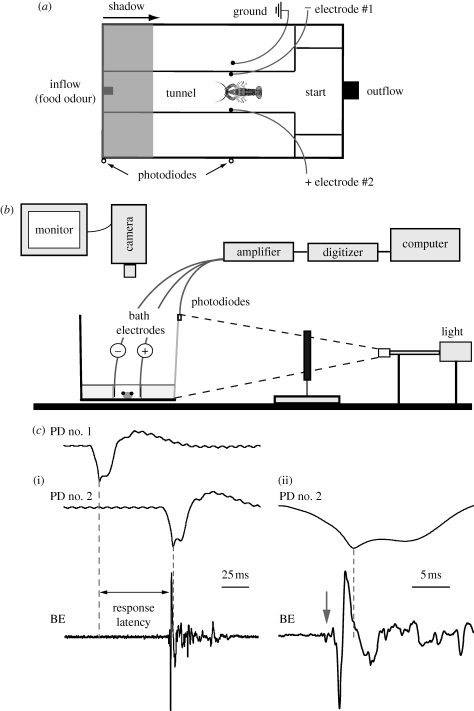Figure 1.
Experimental set-up and signal recordings. (a) Top view of the experimental tank. Water containing the food odour flows into a tunnel on the left side and exits on the right. Animals enter the tunnel from the start compartment and approach the food odour release point. A pair of bath electrodes is attached to the tunnel walls, 8 cm from the tunnel entrance and 17.5 cm from the end. Shadows (indicated as the grey shaded area) always move from left to right over the tank. Photodiodes are placed on the front of the tank to measure shadow velocity and position. (b) Side view of the set-up. Animals inside the tank are filmed with a camera positioned above the tank. The camera is connected to a TV monitor. Bath electrodes and photodiodes are connected to an amplifier and digitizer and recorded signals are stored on a computer. The shadow is produced by moving a plastic rectangle through a light beam directed onto the front of the tank. The tank wall facing the light is covered with a white translucent paper. (c) Example of recorded signals from bath electrodes and photodiodes for a shadow moving at 2.5 m s−1. (i) Recording traces of two photodiodes spaced 175 mm apart. The first photodiode (PD no. 1) was placed at the front edge of the tank and recorded the shadow when it first became visible. The second photodiode (PD no. 2) was placed at the position of the bath electrodes in the tank, i.e. the position of the animal when the shadow was released. Response latency was measured between the peak response of PD no. 1 and the beginning of the field potential that was generated by the tail-flip response and recorded by the bath electrodes (BE). (ii) Traces from PD no. 2 and BE at higher temporal resolution. The animal initiated a tail-flip response (arrow) 4 ms before the shadow produced the peak response in PD no. 2. The first small deflection in the BE trace is owing to the activation of the MG neurons (arrow), while the large phasic potential and the smaller more erratic potentials that follow are owing to muscular activity during tail-flips.

